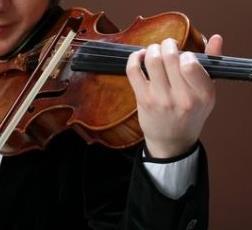Tips for hand position, bow distribution and intonation from The Strad Archive

Three key points to watch in playing thirds are:
1. Position the hand slightly more in favour of the upper finger of each third than the lower finger, and reach back with the lower finger. Do not base the hand position on the lower finger, stretching the upper finger forward.
2. To play a double-stop at the same volume as a single-stop you have to play twice as heavily with the bow, but the fingers should still stop the strings lightly.
3. If there is tension in the fourth finger, release it by relaxing the base knuckle joint of the first finger.
Simon Fischer, The Strad, September 1996
A common mistake is the exclusive concentration on intonation without considering the placement and angle of the left hand. When the hand position is not correct, ease and agility in all positions, and thus good intonation, becomes impossible. To develop a good position I first recommend exploring thirds with the following exercise:

Finger placement should be lightly rounded (note especially the angle of the little finger) and should remain unchanged in all positions. This exercise also assists in developing sensitivity to the difference between major and minor thirds.
Zakhar Bron, The Strad, May 1999
Many players find scale passages in thirds particularly difficult to play in tune. There are frequent changes of position and to complicate matters further the intervals are sometimes major and sometimes minor. If we study the movements of the left hand in a typical passage, such as the G major scale, we find that the principal difficulty is to control the spacing of the 1st and 3rd fingers at a change of position. As the hand slides to the new position these fingers remain on the strings, and they must be set to the correct spacing for the upper interval during the progress of the slide itself. While slight final adjustments may be made ‘by ear’ to secure exact intonation, it is important to bring the fingers as nearly as possible to the correct stops before the interval is sounded at all. During the shift the finger spacing between fingers 1 and 3 should remain precisely constant.
Dr H.R. Allan, The Strad, On Playing Thirds in Tune, 1959
- Read: 12 strategies for teaching adolescents
- Read: How I interpret Bach: Tomás Cotik on strings, intonation and vibrato
- Read: 5 ways to build fourth finger strength
De Beriot, in his violin school, very wisely wrote: 'True intonation in double strings requires an exquisite sense of harmony. In order to acquire this precious quality, the pupil must become familiar with those thirds and sixths which are consonant with the open strings G and D. These lower strings are only set in motion when the higher stopping is played with the most perfect accuracy; then a third sound is produced, which serves as a regulator to the ear and to the position of the fingers. This true intonation of double strings once acquired will extend to all parts of the violin.'
Percival Hodgson, The Strad, December 1916
You can improve your playing in 3rds by practising placing the fingers separately. Put the third finger down on its own, without the first finger. Balance the hand so that the third finger is naturally curved, relaxed and comfortable.
1. Without altering the balance of the hand, or the shape of the third finger, reach back with your first finger and play a major or minor 3rd.
2. Without changing anything else, go back to playing only the third finger without the first finger on the string. Imagine seeing two photos of your hand and third finger, one taken before reaching back with the first finger and the other after removing it from the string. The shape of your hand in both pictures should be identical.
Simon Fischer, The Strad, March 2012


































No comments yet